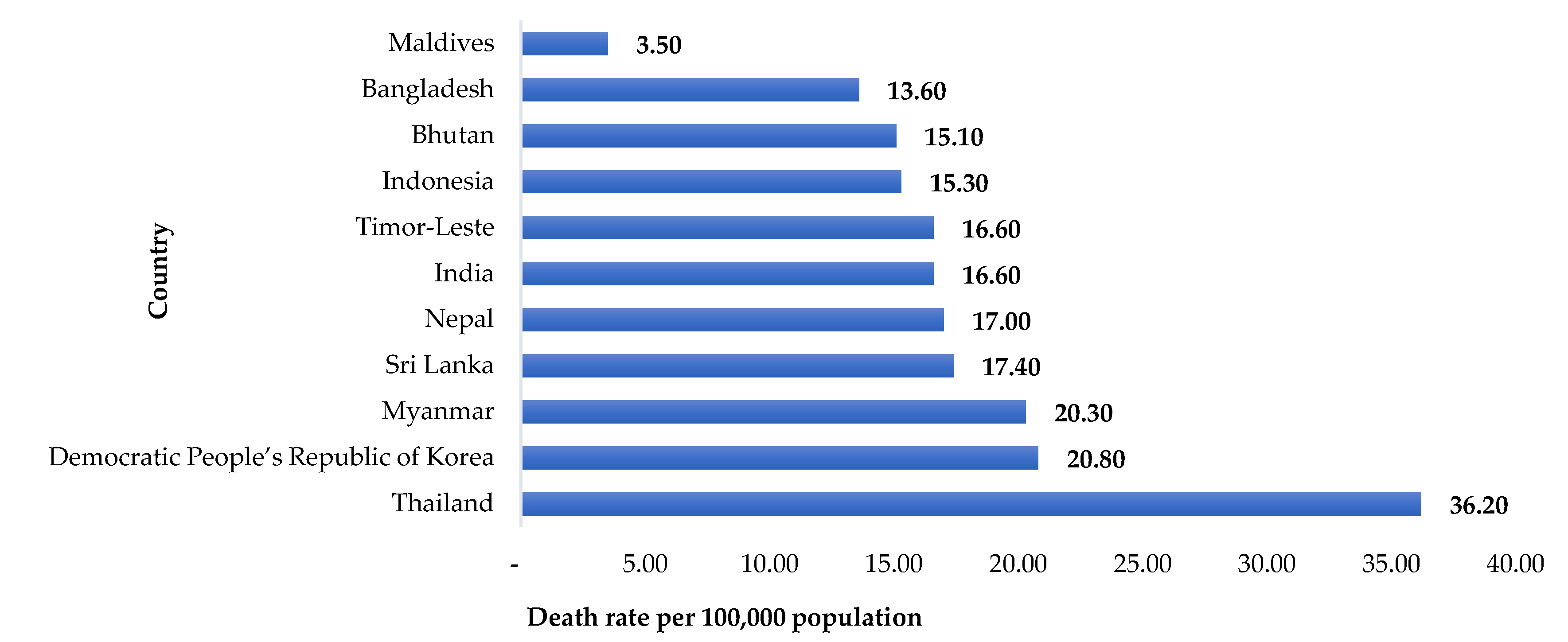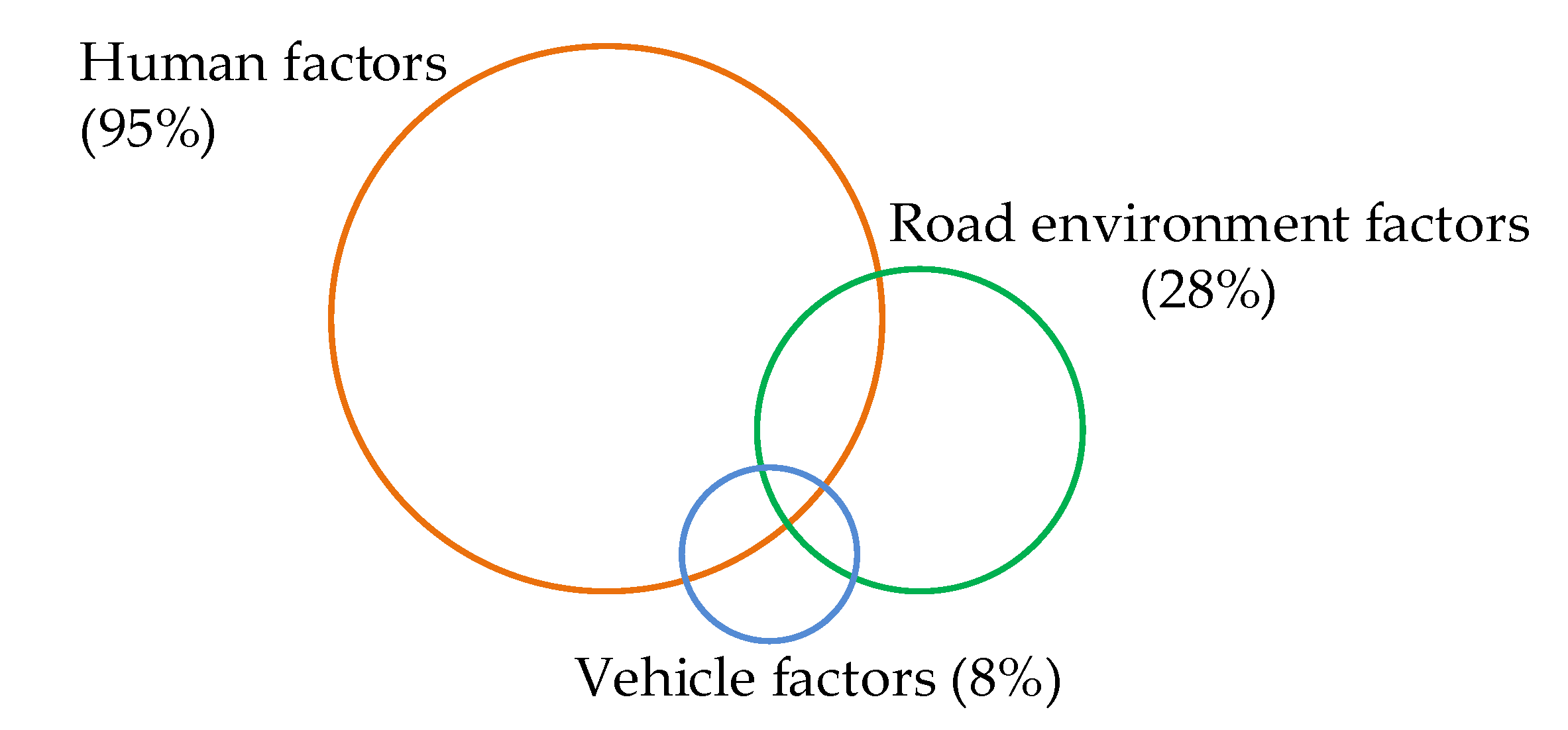Development of Self-Assessment Indicators for Motorcycle Riders in Thailand: Application of the Motorcycle Rider Behavior Questionnaire (MRBQ)
Abstract
1. Introduction
1.1. Motorcycle Accident Situation
1.2. Studies on Human Factors of Riding Behaviors
1.3. Research Objectives and Contributions
2. Materials and Methods
2.1. Procedure
2.2. Materials and Participants
2.2.1. The Motorcycle Rider Behavior Questionnaire (MRBQ)
2.2.2. Participants
2.2.3. Sample Characteristics
2.2.4. Hypothesis Testing
3. Results
3.1. Normality and Correlation
3.2. Reliability
3.3. Model Parameter Estimation
4. Discussion
5. Conclusions, Limitations, and Future Work
Author Contributions
Funding
Acknowledgments
Conflicts of Interest
References
- WHO. Global Status Report on Road Safety 2018; World Health Organization: 20 Avenue Appia, 1211 Geneva 27, Switzerland, 2018. [Google Scholar]
- WHO. World Health Statistics 2017: Monitoring Health for the SDGs, Sustainable Development Goals; World Health Organization: 20 Avenue Appia, 1211 Geneva 27, Switzerland, 2017. [Google Scholar]
- Department of Land Transport. Transport Statistics. Available online: http://apps.dlt.go.th/statistics_web/vehicle.html (accessed on 31 January 2020).
- Royal Thai Police. Directory Listing of Files/Traffic Accident. Available online: http://pitc.police.go.th/dirlist/dirlist.php?dir=/traffic (accessed on 3 February 2020).
- Olson, P.L.; Dewar, R.E. Human Factors in Traffic Safety; Lawyers & Judges Publishing Company, Inc.: Tucson, AZ, USA, 2002. [Google Scholar]
- Shinar, D. Traffic Safety and Human Behavior; Emerald Group Publishing Limited: Howard House, Bingley, UK, 2007. [Google Scholar]
- Royal Thai Police. Traffic Accident on National Highways in 2018. Available online: https://www.m-society.go.th/ewt_news.php?nid=19593 (accessed on 30 October 2018).
- Evans, L. Human Behavior and Traffic Safety; Springer Publishing Company: New York, NY, USA, 2012. [Google Scholar]
- Elliott, M.A.; Baughan, C.J.; Sexton, B.F. Errors and violations in relation to motorcyclists’ crash risk. Accid. Anal. Prev. 2007, 39, 491–499. [Google Scholar] [CrossRef] [PubMed]
- Özkan, T.; Lajunen, T.; Doğruyol, B.; Yıldırım, Z.; Çoymak, A. Motorcycle accidents, rider behaviour, and psychological models. Accid. Anal. Prev. 2012, 49, 124–132. [Google Scholar] [CrossRef] [PubMed]
- Sakashita, C.; Senserrick, T.; Lo, S.; Boufous, S.; Rome, L.D.; Ivers, R. The Motorcycle Rider Behavior Questionnaire: Psychometric properties and application amongst novice riders in Australia. Transp. Res. Part F Traffic Psychol. Behav. 2014, 22, 126–139. [Google Scholar] [CrossRef]
- Stephens, A.N.; Brown, J.; de Rome, L.; Baldock, M.R.J.; Fernandes, R.; Fitzharris, M. The relationship between Motorcycle Rider Behaviour Questionnaire scores and crashes for riders in Australia. Accid. Anal. Prev. 2017, 102, 202–212. [Google Scholar] [CrossRef]
- Lin, M.-R.; Kraus, J.F. A review of risk factors and patterns of motorcycle injuries. Accid. Anal. Prev. 2009, 41, 710–722. [Google Scholar] [CrossRef]
- Hongsranagon, P.; Khompratya, T.; Hongpukdee, S.; Havanond, P.; Deelertyuenyong, N. Traffic risk behavior and perceptions of Thai motorcyclists: A case study. Iatss Res. 2011, 35, 30–33. [Google Scholar] [CrossRef]
- Stephan, K.; Kelly, M.; McClure, R.; Seubsman, S.-A.; Yiengprugsawan, V.; Bain, C.; Sleigh, A. Distribution of transport injury and related risk behaviours in a large national cohort of Thai adults. Accid. Anal. Prev. 2011, 43, 1062–1067. [Google Scholar] [CrossRef]
- Vlahogianni, E.I.; Yannis, G.; Golias, J.C. Overview of critical risk factors in Power-Two-Wheeler safety. Accid. Anal. Prev. 2012, 49, 12–22. [Google Scholar] [CrossRef]
- Moskal, A.; Martin, J.-L.; Laumon, B. Risk factors for injury accidents among moped and motorcycle riders. Accid. Anal. Prev. 2012, 49, 5–11. [Google Scholar] [CrossRef]
- Sukor, N.S.A.; Tarigan, A.K.M.; Fujii, S. Analysis of correlations between psychological factors and self-reported behavior of motorcyclists in Malaysia, depending on self-reported usage of different types of motorcycle facility. Transp. Res. Part F Traffic Psychol. Behav. 2017, 46, 509–523. [Google Scholar] [CrossRef]
- Keall, M.D.; Newstead, S. Analysis of factors that increase motorcycle rider risk compared to car driver risk. Accid. Anal. Prev. 2012, 49, 23–29. [Google Scholar] [CrossRef] [PubMed]
- Chung, Y.-S.; Wong, J.-T. Beyond general behavioral theories: Structural discrepancy in young motorcyclist’s risky driving behavior and its policy implications. Accid. Anal. Prev. 2012, 49, 165–176. [Google Scholar] [CrossRef] [PubMed]
- Kankrong Piyaprai. A Study of Young Driver Behavior that Affect the Risk of Accidents from the Motorcycle; Suranaree University of Technology: Nakhon Ratchasima, Thailand, 2015. [Google Scholar]
- de Rome, L.; Fitzharris, M.; Baldock, M.; Fernandes, R.; Ma, A.; Brown, J. The prevalence of crash risk factors in a population-based study of motorcycle riders. Injury 2016, 47, 2025–2033. [Google Scholar] [CrossRef] [PubMed]
- Reason, J.; Manstead, A.; Stradling, S.; Baxter, J.; Campbell, K. Errors and violations on the roads: A real distinction? Ergonomics 1990, 33, 1315–1332. [Google Scholar] [CrossRef]
- Golob, T.F. Structural equation modeling for travel behavior research. Transp. Res. Part B Methodol. 2003, 37, 1–25. [Google Scholar] [CrossRef]
- Stevens, J. Applied Multivariate Statistics for the Social Sciences; Lawrence Erlbaum Associates: Mahwah, NJ, USA, 1996. [Google Scholar]
- Hu, L.T.; Bentler, P.M. Cutoff criteria for fit indexes in covariance structure analysis: Conventional criteria versus new alternatives. Struct. Equ. Modeling A Multidiscip. J. 1999, 6, 1–55. [Google Scholar] [CrossRef]
- Deb, S.; Ali Ahmed, M. Determining the service quality of the city bus service based on users’ perceptions and expectations. Travel Behav. Soc. 2018, 12, 1–10. [Google Scholar] [CrossRef]
- Lai, W.-T.; Chen, C.-F. Behavioral intentions of public transit passengers—The roles of service quality, perceived value, satisfaction and involvement. Transp. Policy 2011, 18, 318–325. [Google Scholar] [CrossRef]
- Daire Hooper, J.C.; Mullen, M. Structural Equation Modelling: Guidelines for Determining Model Fit. Electron. J. Bus. Res. Methods 2008, 6, 53–61. [Google Scholar]
- Jomnonkwao, S.; Sangphong, O.; Khampirat, B.; Siridhara, S.; Ratanavaraha, V. Public transport promotion policy on campus: Evidence from Suranaree University in Thailand. Public Transp. 2016, 8, 185–203. [Google Scholar] [CrossRef]
- Maskey, R.; Fei, J.; Nguyen, H.-O. Use of exploratory factor analysis in maritime research. Asian J. Shipp. Logist. 2018, 34, 91–111. [Google Scholar] [CrossRef]
- Cerny, B.A.; Kaiser, H.F. A Study of a Measure of Sampling Adequacy for Factor-Analytic Correlation Matrices. Multivar. Behav. Res. 1977, 12, 43–47. [Google Scholar] [CrossRef] [PubMed]
- Kline, R.B. Principles and Practice of Structural Equation Modeling; Guilford Press: New York, NY, USA, 2011. [Google Scholar]
- Nunnally, J.C. Psychometric Theory; McGraw-Hill: New York, NY 10019, USA, 1978. [Google Scholar]
- Hair, J.F.; Black, W.C.; Babin, B.J. Multivariate Data Analysis: A Global Perspective; Pearson Education Ltd.: Harlow, UK, 2010. [Google Scholar]
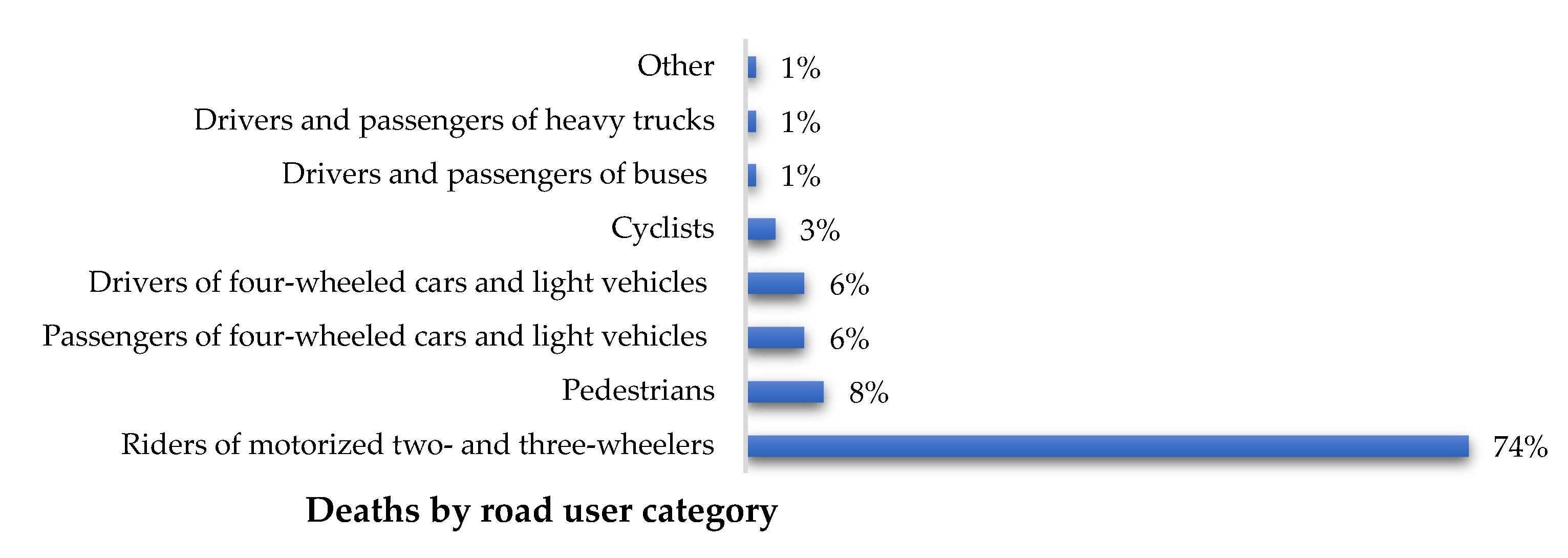
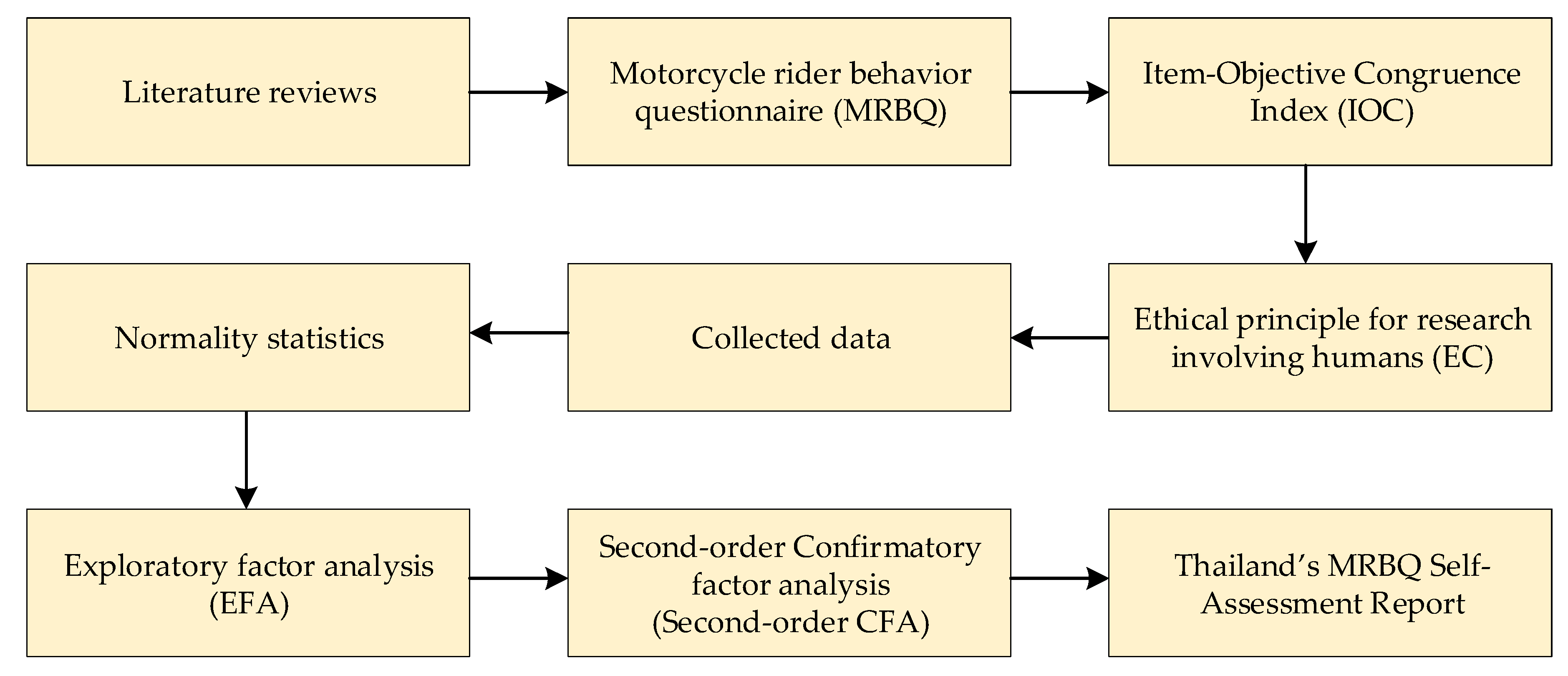
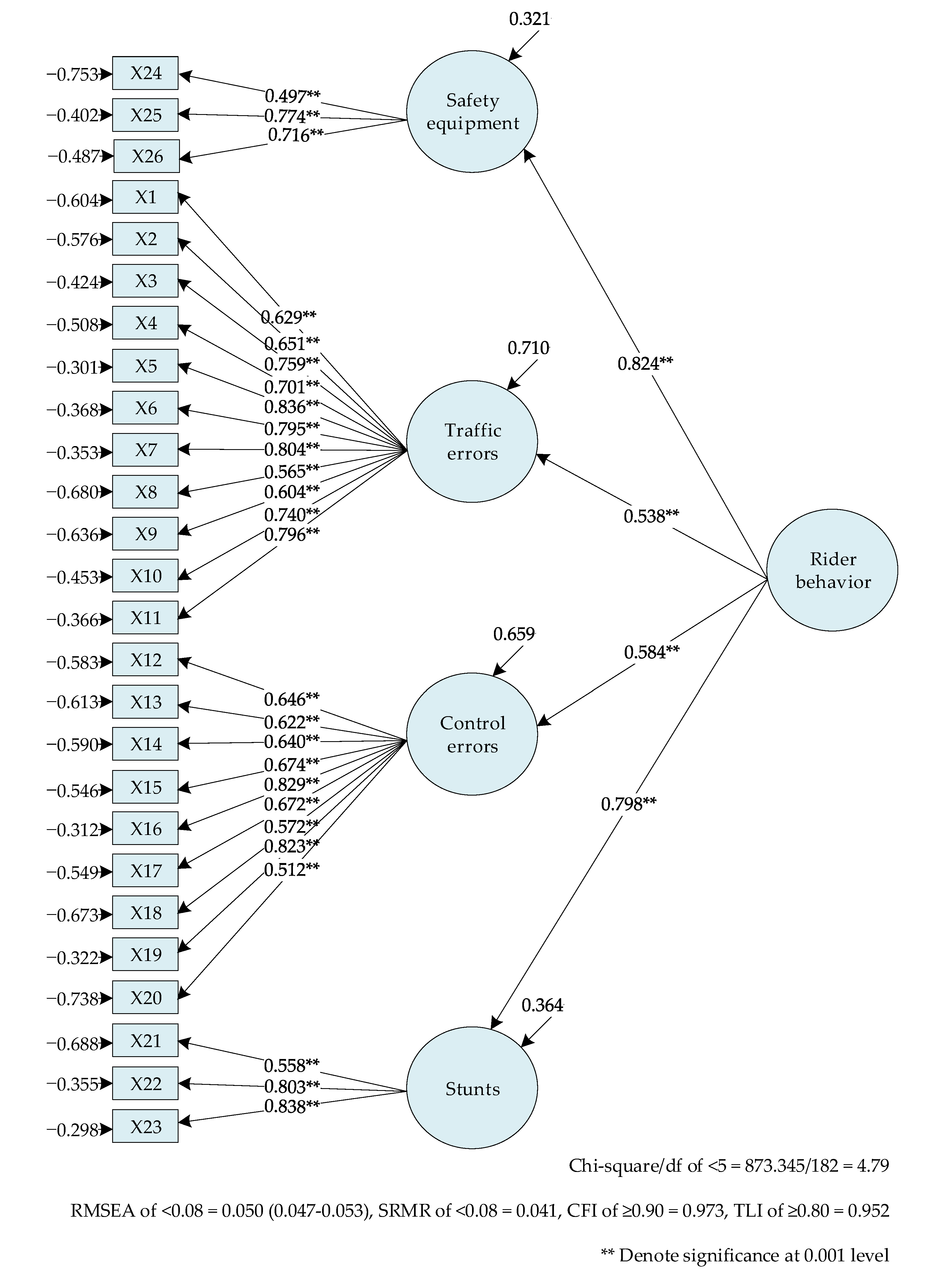
| Author | Method | Speeding Violations | Traffic Errors | Control Errors | Stunts | Safety Equipment | Demographics | Alcohol |
|---|---|---|---|---|---|---|---|---|
| Elliott et al. [9] | Principal component analysis (PCA), linear modeling | √ | √ | √ | √ | √ | √ | - |
| Özkan et al. [10] | descriptive statistics, regression, PCA, theory of planned behavior (TPB), health belief model (HBM), locus of control (LC) | √ | √ | √ | √ | √ | √ | - |
| Sakashita et al. [11] | Exploratory factor analysis (EFA), confirmatory factor analysis (CFA), possion regression | √ | √ | √ | √ | √ | √ | √ |
| Stephens et al. [12] | Descriptive statistics, EFA | √ | √ | √ | √ | √ | √ | - |
| Lin and Kraus [13] | Haddon’s matrix | √ | - | - | - | - | √ | √ |
| Hongsranagon et al. [14] | Descriptive statistics | √ | - | - | - | - | √ | √ |
| Stephan et al. [15] | Descriptive statistics, distribution, frequency | - | - | - | - | - | √ | √ |
| Vlahogianni et al. [16] | Reviews | √ | √ | √ | √ | √ | √ | √ |
| Moskal et al. [17] | Descriptive statistics | - | - | - | - | - | √ | √ |
| Sukor et al. [18] | Quantitative analysis, structural equation modeling (SEM) | √ | - | - | - | √ | √ | - |
| Keall and Newstead [19] | Descriptive statistics, logistic model | - | - | - | - | - | √ | - |
| Chung and Wong [20] | Multi-group, path analysis | - | - | √ | - | - | √ | - |
| Kankrong Piyaprai [21] | Descriptive statistics, TPB | √ | - | √ | √ | - | √ | √ |
| de Rome et al. [22] | Descriptive statistics | - | - | - | - | - | √ | - |
| This research | EFA, second-order CFA | √ | √ | √ | √ | √ | √ | - |
| Address Zone | City/Municipal | Municipality | Municipal District | Outside the Municipality | Total |
|---|---|---|---|---|---|
| Bangkok Metropolis | 59 | 80 | 99 | 63 | 301 |
| Central | 52 | 174 | 62 | 13 | 301 |
| Northeastern | 18 | 69 | 175 | 52 | 314 |
| Northern | 54 | 32 | 128 | 86 | 300 |
| Southern | 85 | 87 | 123 | 5 | 300 |
| Total | 268 | 442 | 587 | 219 | 1516 |
| Personal Data | Quantity (Percentage) |
|---|---|
| Gender | |
| Male | 903 (59.6) |
| Female | 613 (40.4) |
| Age | |
| 20–24 years old | 201 (13.3) |
| 25–34 years old | 594 (39.2) |
| 35–44 years old | 427 (28.2) |
| 45–54 years old | 254 (16.8) |
| 55–64 years old | 33 (2.2) |
| >65 yearsold | 7 (0.5) |
| Licensed rider | |
| Yes | 1385 (91.4) |
| No | 131 (8.6) |
| Type of rider license | |
| Temporary driving license (1 year) | 94 (6.2) |
| Driving license (5 years) | 1065 (70.3) |
| Permanent driving license | 227 (15.0) |
| Riding experience | |
| 0–5 years | 237 (15.6) |
| 6–10 years | 399 (26.3) |
| 11–15 years | 302 (19.9) |
| 16–20 years | 204 (13.5) |
| >20 years | 374 (24.7) |
| Riding frequency | |
| Everyday | 531 (35.0) |
| 4–6 days/week | 554 (36.5) |
| 1–3 days/week | 431 (28.4) |
| Helmet wearing behavior | |
| Always | 271 (17.9) |
| Often | 929 (61.3) |
| Sometimes | 316 (20.8) |
| Riding objective | |
| School/work | 1144 (75.5) |
| Travel | 159 (10.5) |
| Shopping | 213 (14.1) |
| Indicators | Questions | Mean | SD | Skewness | Kurtosis | Exploratory Factor Analysis (EFA) Factor Score | |||
|---|---|---|---|---|---|---|---|---|---|
| Traffic Errors | Control Errors | Stunts | Safety Equipment | ||||||
| Traffic errors | Cronbach ’s α = 0.925 | ||||||||
| X1 | Turning into a side street from a main road without being wary of any pedestrians. | 1.91 | 0.742 | 0.308 | −0.649 | 0.742 | |||
| X2 | Failing to notice a car from behind a parked vehicle until it is nearly too late. | 1.88 | 0.676 | 0.412 | 0.124 | 0.702 | |||
| X3 | Not stopping the motorcycle at zebra crossings to let pedestrians cross the road. | 1.77 | 0.744 | 0.403 | −1.107 | 0.795 | |||
| X4 | Turning left into a main road without reducing speed and not noticing other vehicles. | 1.99 | 0.736 | 0.266 | −0.460 | 0.584 | |||
| X5 | Ignoring the “GIVE WAY” sign when driving on narrow roads and not letting a driver from the other lane proceed. | 1.92 | 0.845 | 0.328 | −1.098 | 0.828 | |||
| X6 | Overtaking without giving a signal in advance. | 1.85 | 0.724 | 0.591 | 0.209 | 0.713 | |||
| X7 | If there are no cars on the road, you continue to go straight while ignoring red traffic lights. | 1.75 | 0.707 | 0.477 | −0.619 | 0.800 | |||
| X8 | Getting involved in unofficial “races” starting from traffic light junctions. | 1.53 | 0.641 | 0.893 | 0.139 | 0.714 | |||
| X9 | Overtaking in an overtaking-prohibited area. | 2.11 | 0.730 | −0.023 | −0.803 | 0.582 | |||
| X10 | Driving against the lane direction or the wrong way on a one-way street. | 1.85 | 0.709 | 0.228 | −0.998 | 0.670 | |||
| X11 | Violating red traffic lights. | 1.89 | 0.757 | 0.193 | −1.237 | 0.704 | |||
| Control errors | Cronbach ’s α = 0.887 | ||||||||
| X12 | Riding without caution about any vehicle pulling out in front of you and having difficulty stopping. | 2.30 | 0.747 | 0.067 | −0.364 | 0.692 | |||
| X13 | When the vehicle ahead slows down or stops, you realize that you should stop your motorcycle immediately. | 2.25 | 0.732 | 0.217 | −0.164 | 0.722 | |||
| X14 | Riding too close to the car in front. If there is an emergency, it will be difficult to stop. | 2.21 | 0.688 | −0.031 | −0.438 | 0.814 | |||
| X15 | Riding too fast into a corner or junction. | 2.39 | 0.744 | −0.056 | −0.381 | 0.642 | |||
| X16 | Failing to control the motorcycle when using high speed. | 2.22 | 0.711 | −0.006 | −0.457 | 0.591 | |||
| X17 | Braking too quickly on a slippery road. | 2.25 | 0.804 | 0.000 | −0.694 | 0.467 | |||
| X18 | Having trouble with your visor or goggles fogging up. | 2.29 | 0.663 | −0.009 | −0.274 | 0.721 | |||
| X19 | Parking your motorcycle in a prohibited area. | 2.18 | 0.846 | −0.122 | −1.178 | 0.580 | |||
| X20 | Breaking speed limits at late night or early morning. | 2.30 | 0.708 | −0.050 | −0.386 | 0.654 | |||
| Stunts | Cronbach ’s α = 0.747 | ||||||||
| X21 | Pulling away too quickly and your front wheel lifts off the road. | 1.12 | 0.343 | 2.774 | 7.107 | 0.775 | |||
| X22 | Purposely doing a wheel spin. | 1.29 | 0.649 | 1.994 | 2.335 | 0.841 | |||
| X23 | Cutting other vehicles off/overtaking at close range. | 1.58 | 0.900 | 1.588 | 1.971 | 0.742 | |||
| Safety equipment | Cronbach ’s α = 0.831 | ||||||||
| X24 | Wearing motorcycle riding boots/protective trousers or jacket when riding. | 1.74 | 0.953 | 1.501 | 2.572 | 0.869 | |||
| X25 | Wearing a protective riding suit for body, elbow, and shoulder protection. | 1.62 | 0.875 | 1.331 | 1.227 | 0.695 | |||
| X26 | Wearing motorcycle gloves. | 1.96 | 1.095 | 1.103 | 0.748 | 0.839 | |||
| Factors | Traffic Errors | Control Errors | Stunts | Safety Equipment |
|---|---|---|---|---|
| Traffic errors | 1.00 | |||
| Control errors | 0.624 ** | 1.00 | ||
| Stunts | 0.364 ** | 0.386 ** | 1.00 | |
| Safety equipment | 0.297 ** | 0.290 ** | 0.474 ** | 1.00 |
| Indicators | Cronbach’s α | Second-Order CFA | CRI | AVE | |||
|---|---|---|---|---|---|---|---|
| Est. | Est./S.E. | p-Value | R2 | ||||
| Traffic errors | 0.538 | 22.200 | <0.001 ** | 0.290 | |||
| X1 | 0.925 | 0.629 | 38.335 | <0.001 ** | 0.922 | 0.716 | |
| X2 | 0.651 | 41.143 | <0.001 ** | ||||
| X3 | 0.759 | 62.027 | <0.001 ** | ||||
| X4 | 0.701 | 50.708 | <0.001 ** | ||||
| X5 | 0.836 | 95.812 | <0.001 ** | ||||
| X6 | 0.795 | 76.637 | <0.001 ** | ||||
| X7 | 0.804 | 79.278 | <0.001 ** | ||||
| X8 | 0.565 | 32.211 | <0.001 ** | ||||
| X9 | 0.604 | 35.624 | <0.001 ** | ||||
| X10 | 0.740 | 58.965 | <0.001 ** | ||||
| X11 | 0.796 | 75.395 | <0.001 ** | ||||
| Control errors | 0.584 | 24.032 | <0.001 ** | 0.341 | |||
| X12 | 0.887 | 0.646 | 38.307 | <0.001 ** | 0.879 | 0.666 | |
| X13 | 0.622 | 36.391 | <0.001 ** | ||||
| X14 | 0.640 | 40.151 | <0.001 ** | ||||
| X15 | 0.674 | 44.594 | <0.001 ** | ||||
| X16 | 0.829 | 73.353 | <0.001 ** | ||||
| X17 | 0.672 | 45.594 | <0.001 ** | ||||
| X18 | 0.572 | 30.304 | <0.001 ** | ||||
| X19 | 0.823 | 70.397 | <0.001 ** | ||||
| X20 | 0.512 | 24.541 | <0.001 ** | ||||
| Stunts | 0.798 | 31.549 | <0.001 ** | 0.639 | |||
| X21 | 0.747 | 0.558 | 25.244 | <0.001 ** | 0.731 | 0.733 | |
| X22 | 0.803 | 49.746 | <0.001 ** | ||||
| X23 | 0.838 | 55.004 | <0.001 ** | ||||
| Safety equipment | 0.824 | 30.796 | <0.001 ** | 0.679 | |||
| X24 | 0.831 | 0.497 | 16.724 | <0.001 ** | 0.706 | 0.662 | |
| X25 | 0.774 | 56.816 | <0.001 ** | ||||
| X26 | 0.716 | 57.452 | <0.001 ** | ||||
© 2020 by the authors. Licensee MDPI, Basel, Switzerland. This article is an open access article distributed under the terms and conditions of the Creative Commons Attribution (CC BY) license (http://creativecommons.org/licenses/by/4.0/).
Share and Cite
Uttra, S.; Jomnonkwao, S.; Watthanaklang, D.; Ratanavaraha, V. Development of Self-Assessment Indicators for Motorcycle Riders in Thailand: Application of the Motorcycle Rider Behavior Questionnaire (MRBQ). Sustainability 2020, 12, 2785. https://doi.org/10.3390/su12072785
Uttra S, Jomnonkwao S, Watthanaklang D, Ratanavaraha V. Development of Self-Assessment Indicators for Motorcycle Riders in Thailand: Application of the Motorcycle Rider Behavior Questionnaire (MRBQ). Sustainability. 2020; 12(7):2785. https://doi.org/10.3390/su12072785
Chicago/Turabian StyleUttra, Savalee, Sajjakaj Jomnonkwao, Duangdao Watthanaklang, and Vatanavongs Ratanavaraha. 2020. "Development of Self-Assessment Indicators for Motorcycle Riders in Thailand: Application of the Motorcycle Rider Behavior Questionnaire (MRBQ)" Sustainability 12, no. 7: 2785. https://doi.org/10.3390/su12072785
APA StyleUttra, S., Jomnonkwao, S., Watthanaklang, D., & Ratanavaraha, V. (2020). Development of Self-Assessment Indicators for Motorcycle Riders in Thailand: Application of the Motorcycle Rider Behavior Questionnaire (MRBQ). Sustainability, 12(7), 2785. https://doi.org/10.3390/su12072785







